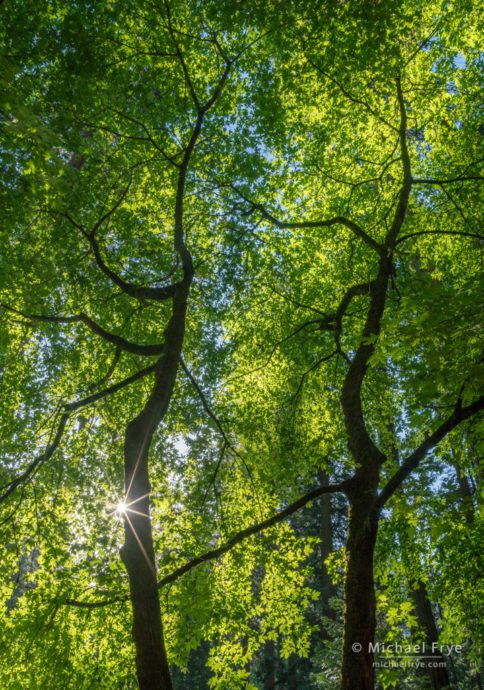A couple of weeks ago Claudia and I were in Yosemite Valley and drove past this maple with beautiful, backlit, bright-green leaves. So we stopped to see if there might be a photograph there. At first I couldn’t find a composition. Although the glowing leaves were beautiful, the light was splotchy, and this tree was right above a tent cabin in Housekeeping Camp, so it was difficult to keep that tent and others out of the picture.
But it seemed like there was something there, so we persisted, me with my big camera, Claudia with her iPhone. The visual clutter caused by the splotchy light, random arrangements of branches, and distracting background objects (the tent cabins) initially seemed to warrant using a telephoto lens, and focusing on a section of the leaves. The longer lens would help simplify things, keep the clutter to a minimum, and focus attention on the leaves themselves, which were what originally caught my eye. But I couldn’t find a group of leaves that had a strong enough pattern, and the photographs didn’t convey the feeling of those glowing leaves.
So I decided to step further back and try a wide-angle lens. The wide lens would allow me to include the sun filtering through the trees, which would create a focal point and add a certain feeling to the image. But the leaves themselves would look smaller, and I knew it would be hard to keep the photograph simple and uncluttered. Eventually I found the composition you see here, with two prominent trunks surrounded by leaves.
Looking at this photograph later it occurred to me that it illustrates what I consider to be the most fundamental, essential elements of composition: simplicity, repetition, and balance.
Simplicity doesn’t necessarily mean a sparing, zen-like appearance (although that can be great). It does mean including only the essentials – the bare minimum needed to convey your idea. And the key elements need to stand out clearly. Here the only objects in the photograph are branches, leaves, and the sun. Including anything else would have diluted the message or created a distraction. And while this photograph is actually pretty busy, with leaves splattered all over the frame, the trunks and sun provide focal points that help to organize the image. I think of focal points as corollaries to the idea of simplicity. A focal point helps clarify the photograph’s message by telling the viewer where to look first. An image that might otherwise be too busy or confusing can suddenly become simple and clear when you add a focal point.
Repetition gives a photograph order, cohesion, and rhythm. Patterns also help to organize and therefore simplify the image. There are two repeating patterns here: the individual leaves splattered across the frame, and the similar shapes of the two trunks – especially just above center, where the limbs branching off to the left on each trunk echo each other.
Balance is often overlooked, but vital. Here the two trunks balance each other, providing equal visual weight to the left and right sides of the frame. The trunks are thicker below, but the branch patterns are more interesting above, so the visual weight is roughly balanced between the top and bottom. The sun creates a strong pull toward the lower-left portion of the image, but then the trunks lead the eye toward a bright patch of leaves in the upper-right, so there’s a dynamic balance between the lower-left and upper-right corners.
Was I thinking about all that when photographing those maples? Of course not. I was just looking for something that worked. But I’ve had lots of practice trying to simplify compositions, look for patterns, and feel the balance within the frame. All that practice helped me find and recognize a composition that might be effective.
There are no shortcuts or magic formulas for improving your compositions. It does take practice. But you can accelerate the process by making a conscious effort to simplify, look for repetition, and pay attention to balance.
— Michael Frye
Related Posts: When Does a Photograph Need a Focal Point?; Cloud Patterns; Finding Rhythm
Michael Frye is a professional photographer specializing in landscapes and nature. He is the author or principal photographer of The Photographer’s Guide to Yosemite, Yosemite Meditations, Yosemite Meditations for Women, Yosemite Meditations for Adventurers, and Digital Landscape Photography: In the Footsteps of Ansel Adams and the Great Masters. He has also written three eBooks: Light & Land: Landscapes in the Digital Darkroom, Exposure for Outdoor Photography, and Landscapes in Lightroom: The Essential Step-by-Step Guide. Michael has written numerous magazine articles on the art and technique of photography, and his images have been published in over thirty countries around the world. Michael has lived either in or near Yosemite National Park since 1983, currently residing just outside the park in Mariposa, California.










Thanks for sharing this beautiful image and really great info.
Thanks so much Nik!
This is a great composition! I love how the two maple trunks mirror each other, angling outward to their notches, then curving in and finally curving to embrace the bright patch in the upper right. I also like the diagonal made by the lower branches of the tree on the right reinforcing the line from the sun to the bright patch. As always, I learn a lot from your posts!
Thanks Peter! Obviously there was some luck involved here in the way those trees grew, but one of my points in this post was that you can train yourself to look for repetition, and increase the odds that you’ll find and recognize such patterns.
I really look forward to your blog posts! With the help of your books and your posts I’m learning a great deal. I would agree with another post I read in that your writing/teaching style is easy to follow and understand. Hopefully I’ll be able to attend one of your workshops next year!
Thanks Elena – glad you’re enjoying the posts!